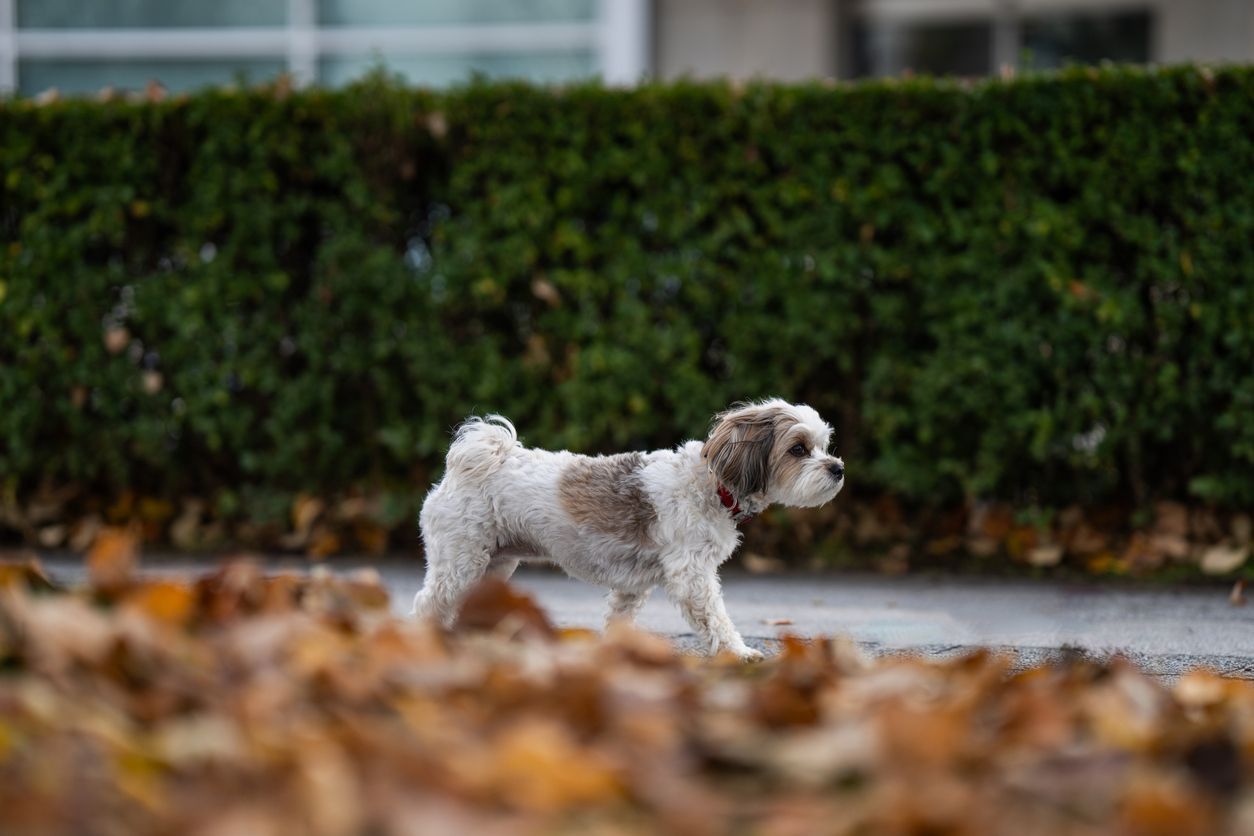Treatment for degenerative myelopathy in dogs

Disclaimer: This article, its content, and its related references do not constitute veterinary advice and should not be considered a substitute for veterinary care. If your pet is showing any symptoms that could indicate a medical emergency, please seek immediate emergency care.
Degenerative myelopathy (DM) is a genetic, progressive, and eventually fatal neurologic condition in dogs. The disease affects the spinal cord and results in progressive difficulty walking and paralysis. If your dog’s been diagnosed with DM, read on to learn more about:
- Symptoms of degenerative myelopathy
- Methods to improve quality of life
- How to help your dog with degenerative myelopathy
Clinical signs associated with DM, such as weak hind limbs and loss of coordination, occur with many other diseases, so veterinary attention is necessary for an accurate diagnosis. DM cannot be cured, but progression may be slowed, and quality of life can be improved using physical therapy and exercise, home modification, and other methods of supportive care.
What is canine degenerative myelopathy?
Degenerative myelopathy (DM) is a genetic neurologic condition that affects the spinal cord. The condition results in progressive loss of mobility and bodily function, and gradual paralysis. Eventually, affected dogs become paralyzed and have difficulty breathing and swallowing. DM in dogs is similar to amyotrophic lateral sclerosis (ALS), or Lou Gehrig’s disease, in humans.
Signs of DM are typically seen in dogs over eight years of age. Symptoms typically begin in the hind limbs and progress to the front of the body. The disease is progressive and non-painful but has an overall poor prognosis because it can’t be cured, reversed, or stopped. DM causes a dog to progressively lose the ability to walk and control their bladder and bowels, and eventually makes it difficult for the dog to breathe.
Clinical signs of degenerative myelopathy in dogs
DM is a progressive disease, so symptoms change and progress over time. Symptoms usually start in the rear legs and progress toward the front of the body. Clinical signs of DM in dogs include:
- Knuckling, dragging the toes, or walking on the tops of the feet or wrists
- Loss of coordination (ataxia)
- Difficulty standing from rest
- Hind limb weakness
- Loss of muscle mass (muscle atrophy)
- Bowel and urinary incontinence
- Paralysis
- Difficulty breathing and swallowing
Symptoms of DM also occur with other medical conditions, so a definitive diagnosis from a veterinarian is needed.
Dog breeds at risk for degenerative myelopathy
Genetics plays a role in the development of DM, so it’s more prominent in some breeding lines than others. Though any breed of dog can be affected, DM is more commonly seen in large-breed dogs. At-risk breeds for DM include:
- German shepherd
- Boxer
- Pembroke Welsh corgi
- Chesapeake Bay retriever
- Rhodesian ridgeback
- Bernese mountain dog
Even though there’s no specific diagnostic test for DM, genetic testing can show if a dog has one or two copies of the genetic mutation associated with the disease. Carriers of the genetic abnormality may or may not develop the disease.
Average survival time of dogs with degenerative myelopathy
DM is a progressive, fatal disease. Most dogs are unable to walk a year after diagnosis, and suffer from urinary and fecal incontinence, difficulty swallowing, and difficulty breathing after three to four years. When the quality of life of the affected dog becomes poor, humane euthanasia may be the most compassionate option.
Treatment options for degenerative myelopathy in dogs
Since several diseases can cause the same symptoms associated with DM, a dog needs to be diagnosed by a veterinarian before a treatment plan can be recommended. Other conditions that have similar symptoms may require different care.
Typical diagnostic tests include:
- Complete neurologic exam
- Blood tests
- Diagnostic imaging
- Analysis of cerebrospinal fluid
DM is often a diagnosis of exclusion, meaning other conditions are ruled out with testing first. Because DM is a genetic disease and a genetic variant associated with DM has been identified, genetic testing can show if your dog is a carrier. Testing can be done on any dog, whether they have symptoms or not. It will show if your dog has one or two copies of the genetic mutation. However, this doesn’t predict whether the dog will develop the disease, and genetic testing alone can’t accurately diagnose DM in dogs who are displaying symptoms.
DM can’t be cured, reversed, or halted. Treatment methods focus on improving quality of life by helping the dog get around and remain as comfortable as possible for as long as possible. “The best way to help a dog with DM is to follow your veterinarian’s recommendations, which may include physical therapy, home modification, and supportive care,” explains Dr. Jo Myers, a veterinarian on the Vetster platform.
Physical therapy and regular exercise
Physical therapy and exercise directed by a veterinarian are used to try to help slow the progression of DM, maintain a healthy weight, and maintain muscle mass. However, they won’t completely stop the progression of the disease. Physical therapy exercises may include:
- Swimming
- Underwater treadmills
- Short, frequent walks
- Assisted stretching
- Massage
- Sit-to-stand exercises
- Assisted walking with slings, harnesses, or wheelchairs
- Electrotherapy
As the disease progresses, assistive devices may be needed to help support the dog while walking or using the bathroom.
Physical therapy and exercise should be directed by a veterinarian to ensure they’re safe and beneficial for the dog. Methods may change as the disease progresses, and the help of an animal physical therapist may be beneficial.
Home modifications
Owners of dogs with DM can modify their homes to help their dogs get around and keep them more comfortable. This can involve:
- Nonslip mats or carpet on hard floors
- Pet ramps or stairs near furniture and for entering/exiting the car
- Boots to reduce trauma to the feet and nails
- Ample soft bedding to rest on and prevent pressure sores
Home modification strategies don’t necessarily require a veterinarian’s guidance. However, a vet may be able to make recommendations based on your home and dog’s individual needs.
Supportive care
Additional home nursing care may be needed as the disease progresses and symptoms change. Supportive care can include:
- Pet diapers and care for urine scald
- Treatment of secondary complications, such as UTIs
- Hand feeding
- Regularly moving to prevent pressure sores
A veterinary professional may be able to provide advice on home nursing care based on your dog’s symptoms and needs.
How to help your dog with degenerative myelopathy
It’s important to seek veterinary attention if your dog exhibits any sign of neurologic problems, such as changes in gait, knuckling of the toes, or difficulty walking normally. If your dog is diagnosed with DM, you can help them by using various methods, including:
- Vet-recommended physical therapy, exercise, and other therapies
- Home modification and assistance walking
- Supportive care for symptoms, secondary infections, and overall comfort
Every dog with DM will have different needs. A vet professional can help create a management plan to maintain your dog’s quality of life for as long as possible. Online virtual care appointments are great for support with new management strategies as new symptoms emerge without needing to take your dog to a clinic.
FAQ - Treatment for degenerative myelopathy in dogs
How long can a dog live with degenerative myelopathy?
Most dogs are unable to walk within a year of diagnosis of degenerative myelopathy. Symptoms progress to fecal and urinary incontinence and difficulty breathing within three to four years. The survival time of dogs with degenerative myelopathy is around three to five years after diagnosis, though every dog is different.
How do you slow the progression of degenerative myelopathy in dogs?
Management strategies that may slow the progression of degenerative myelopathy include veterinary-guided physical therapy, exercise, and other medical therapy methods. There is no treatment method that will completely halt the progression of the disease, but it may be slowed in some dogs.
What is the best treatment for degenerative myelopathy in dogs?
There is no effective treatment that will completely stop the clinical progression of degenerative myelopathy in dogs or cure the disease. However, veterinary-recommended therapy methods, such as physical therapy and regular exercise, may help slow disease progression in some dogs.




